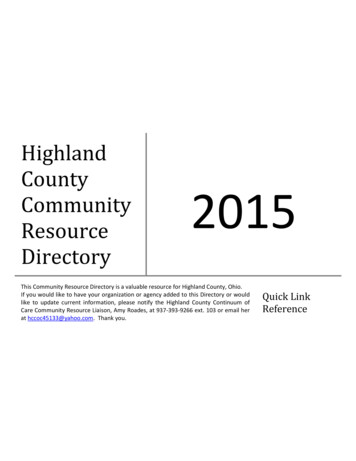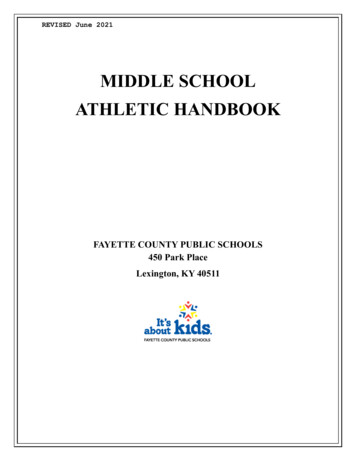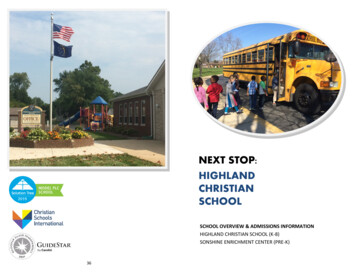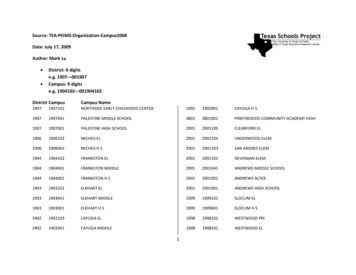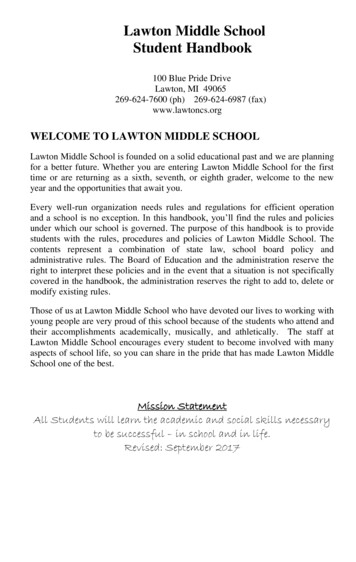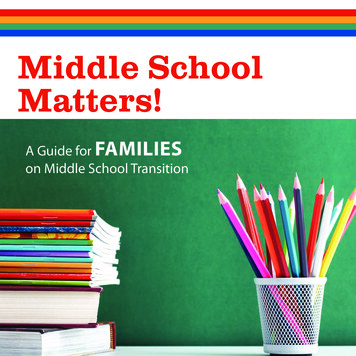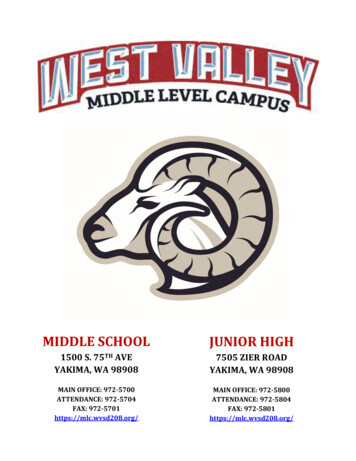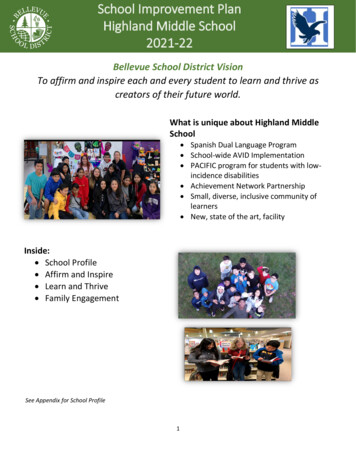
Transcription
School OverviewDemographicsEnrollmentSchool Improvement PlanHighland Middle School2021-22Bellevue School District VisionTo affirm and inspire each and every student to learn and thrive ascreators of their future world.What is unique about Highland MiddleSchool Spanish Dual Language Program School-wide AVID Implementation PACIFIC program for students with lowincidence disabilities Achievement Network Partnership Small, diverse, inclusive community oflearners New, state of the art, facilityInside: School Profile Affirm and Inspire Learn and Thrive Family EngagementSee Appendix for School Profile1
Affirm and InspireStudent Well-BeingStrategic Plan Student Well-Being Goal: Students feel safe, affirmed, and inspired to achieve high levels of socialemotional well-being regardless of background.Student Well-Being Priority: Sense of BelongingAs students re-enter the full school experience, school-based strategies will contribute to an inclusive environmentwhere all students feel a sense of belonging. Studies have shown that “a strong sense of belonging translates to studentsof all ages and developmental stages improving academically, being more engaged and motivated in school, andincreasing their physical and emotional health.” 1Sense of Belonging Measures and TargetsIncrease percentage of students reporting a sense of belonging on the Panorama student survey, with a reduction inpredictable outcomes by subgroup.Panorama Survey School Climate Domain - Sense of Belonging Percentage FavorableGrades 6-8Student GroupsBaseline 2017Fall 2019All Students48% (449)52% (438)Asian49% (70)50% (76)Black*51% (33)Hispanic54% (122)58% (170)Multi-ethnic49% (32)*White46% (142)47% (126)Students with Disabilities52% (58)53% (44)English Learners53% (75)58% (106)Low Income50% (200)54% (213)Fall 2021*Data suppressed due to small group size, in order to protect student privacy.Note: As a general rule of thumb, a difference of 4 or more percentage points is considered meaningful on the Panorama survey.Data ReflectionThe data reflect an increase in sense of belonging overall and for subgroups that had enough students to report.While it is an increase, nearly half of our students do not feel a sense of belonging which is not acceptable as a wholeor for any subgroup. Students at Highland come from very diverse backgrounds and diverse elementary schools.Key Strategies / Adjustments Create a staff vision for Highland: A community of excellence that empowers each student to celebrate theircultural and linguistic identities, nurture their intellect, and cultivate their future. Adopt and embed the tagline in everything we do: Every Eagle, Every Day, Every Way - Cada Águila, cada día,en todos los sentidos (announcements, communications, assemblies, etc.).1Why Student Belonging Matters: October 2020. NASSP. (2020, October 1). /.2
Implement schoolwide PBIS expectations/practices that reflect our beliefs including culturally relevantpractices known as “The Eagle Way.”The development of these practices are on-going as we adjust to our new building, as well as adjusting tobeing in school together for the first time in 18 months.Train staff about and implement Community Circles in classes to encourage safe discussion spaces. Whatdistinguishes a Community Circle from a group discussion is that Community Circles are explicitly used as anopportunity for students to build community.Re-establish and support after-school and extra-curricular programs, including clubs, activities, and athletics.Student Well-Being Priority: Social-Emotional LearningMany students experienced isolation during the pandemic, with few opportunities to interact in-person socially. As wereturn to in-person learning it will be critical to recognize where each student is socially and emotionally and to providethem with intentional opportunities to support their development in social emotional learning. Our universal (tier 1)social emotional learning curriculum encompasses the five CASEL competencies: self-awareness, self-management,social-awareness, relationship skills, and responsible decision-making. These competencies are not discrete and areintegrated into curriculum and instructional practices.Social-Emotional Learning Measures and TargetsIncrease social-emotional competencies from Fall 2021 to Spring 2022.Social Emotional CompetencySelf-ManagementSocial AwarenessSelf-EfficacyGrades 6-8: Panorama Social-Emotional Learning SurveyFall 2020 (n 385)Spring 2021 (n 392)Fall 202177%74%68%65%48%51%Spring 2022Data ReflectionSelf-Management and Social Awareness both decreased over the course of the year, while Self-Efficacy increased. Itis very difficult to know student stories and mindsets during this time of remote learning, especially for the nearly 200students who did not participate in the survey. It is evident we have work to do to instill self-efficacy with all of ourstudents, particularly with our students who make up our historically most marginalized subgroups.Key Strategies / Adjustment Transition PBIS team to Student Well-Being Team to develop a focus and lessons directly tied to socialemotional competencies utilizing resources such as the Panorama Playbook. Lessons to be delivered inadvisory-type classes (for example, set biweekly or monthly assembly schedules where students stay withtheir 2nd or 3rd period teacher for an additional 30 minutes for SEL instruction). Develop Mental Health Assistance Team (MHAT) to identify students with mental health needs and providegreater access to a full spectrum of evidence-based mental health services. MHAT will focus on universalscreening for all 7th and 8th grade students (BIMAS2); identification and referral of students at risk for suicideor in need of mental health supports; and direct service for students in need (individual and group counselingprovided by BSD MHAT counselors). Engage all students in counselor-led Naviance-based lessons focused on self-awareness and self-efficacy:Learning Styles 2.0 (6th grade); Career Interest Inventory (7th grade); Strengths Explorer (8th grade).3
Learn and ThriveAcademic SuccessStrategic Plan Academic Success Goal: Students achieve high levels of academic success and outcomes are notpredicted by race or income.Academic Success Priority: Academic GrowthA significant priority this year will be to measure student proficiency at the beginning of the school year and monitoracademic growth for all students. Regardless of where students begin the year, the goal is for all students to experienceexpected or greater growth.Academic Growth Measures and TargetsIncrease percentage of students in grades 6-8 making typical or high growth in literacy and math from Fall 2021 toSpring 2022.Grades 6-8: Percentage of students showing typical/high growth from fall to springSubgroupStar Reading % Typical/High GrowthFall 2020Fall 2021Spring 2021Spring 2022SBA Math % Typical/High GrowthFall 2020Fall 2021Spring 2021Spring 2022All69% (401)Asian69% (72)Not availableNot availableBlack57% (23)Not availableHispanic69% (138)Not availableMulti-Ethnic74% (34)Not availableWhite71% (133)Not availableLow Income66% (163)Not availableEnglish Learner58% (62)Not availableStudents with Disabilities64% (42)Not availableFemale71% (207)Not availableMale68% (194)Not available*Not availableTraditional69% (399)Not availableGrade 669% (168)Not availableGrade 766% (114)Not availableAdvanced LearningGrade 873% (119)*Data suppressed due to small group size, in order to protect student privacy.Not availableData ReflectionThis data reflects about 68% of the enrolled student body. There was sporadic implementation of testing and it wasdifficult to connect directly with students who chose not to participate. Our goal would be to have at least 80% ormore of all students demonstrate typical/high growth. Our English Learners and Black students scored the lowest ofall subgroups consistent with past trends.Key StrategiesLiteracy Strategies:4
All students complete the Star reading assessment in fall and spring to screen for proficiency and to monitorstudents’ reading growth and progress toward becoming independent readers. Use instructional time in Language Arts, Social Studies and Science to focus on reading growth. The focusduring this time is for all student to work on their reading growth based on their individual needs. During thistime, all 6th grade students will work in Lexia PowerUp. 7th and 8th grade students will work in Lexia PowerUp,Lexia PowerUp Skill Builders, Membean, NewsELA, Springboard, or independent reading. Teachers interactwith small groups or individuals based on student need, conferencing with students, setting goals, andcelebrating students’ success during this time. Teachers monitor progress to ensure students are focused at least 80 minutes per week on reading growthand to identify students who might need additional support and prioritize small group instructions.Math Strategies: All students complete ALEKS assessment in fall and spring to screen for proficiency and to monitor students’growth and progress toward mastering math standards. Math PLCs (department and like-course) meet regularly to understand critical learning goals and unit/lessondesign and plan instruction and examine student work and student achievement outcomes. Continued and expanded implementation of standards-based grading providing an opportunity for teachersto deepen their understanding of standards-aligned instruction.Academic Success Priority: ELA and Math ProficiencyWe recognize that student learning experiences varied widely during the 2019-20 and 2020-21 school years due to thepandemic and the shift in learning models. Universal screeners administered in the fall will provide student proficiencydata for educators as they design instruction and supports based on students’ beginning of the year level in the coresubject areas of literacy and math. Based on progress monitoring data during the 2020-21 school year, math is a focusarea.ELA and Math Proficiency Measures and TargetsIncrease percent of students meeting or exceeding proficiency standards in literacy and math in grades 6-8.Grades 6-8: Percentage of students meeting or exceeding standards in reading and mathStar Reading % ProficientSubgroupSpring 2021All57% (453)Asian70% (84)Black42% (26)Hispanic35% (164)Multi-Ethnic75% (36)White74% (142)Low Income33% (195)English Learners9% (87)Students with Disabilities23% (53)Female62% (232)Spring 20225SBA Math % ProficientFall 2021**Spring 2022
Male52% (221)Advanced Learning*Traditional57% (451)Grade 658% (185)Grade 756% (132)Grade 857% (136)*Data suppressed due to small group size, in order to protect student privacy.**Anticipated to be available in December 2021. Math data for 2020-21 is not shown as it is incomplete.Data ReflectionThe data reflect about 77% of enrolled students. It is evident that students in our historically most marginalizedsubgroups (Black, Hispanic, Low Income, English Learners, and Students with Disabilities) need significant supportwith respect to demonstrating proficiency in reading on the Star assessment. Our goal would be to have a minimumof 80% of all students demonstrating proficiency (meeting or exceeding standards) on the Star test.Key StrategiesLiteracy Strategies: Ensure students are provided regular access to grade-level, complex, non-fiction texts; are challenged withquestions and tasks that are text-specific and accurately address the analytical thinking required by gradelevel standards; and are provided with consistent opportunities to engage in the work of the lesson. Engage in effective use of interim assessment data to inform and support high-quality instruction through the“Teaching and Learning Cycles of Improvement” process to target the instructional needs of students moreaccurately. Department and like-course PLCs meet regularly to understand critical learning goals and unit/lesson designand plan instruction and examine student work and student achievement outcomes. Interdisciplinary PLC structure for learning and understanding of “Reading Apprenticeship” framework whichfocuses on using discipline-specific literacy strategies and establishing routines for discussion andcollaboration that tap students’ own experiences. Teachers’ learning will explore the framework’s fourinteracting dimensions of learning: social, personal, cognitive, and knowledge-building.Math Strategies: Implement Illustrative Math curriculum for IMT 1 and IMT 2 in which students are systematically introducedto representations, contexts, concepts, language, and notation. As their learning progresses, they makeconnections between different representations and strategies, consolidating their conceptual understanding,and see and understand more efficient methods of solving problems, supporting the shift toward proceduralfluency. The distributed practice problems give students ongoing practice, which also supports developingprocedural proficiency. Use Math Language Routines (MLRs), a curated and adapted set of instructional routines that create spaces inwhich student language can grow, to amplify, formatively assess, and develop the variety of ways studentsexpress their own ideas, both in their own everyday language and in disciplinary language. Focus on MLR 1:Stronger and Clearer Each Time, MLR 2: Collect and Display and MLR 3: Critique, Correct, & Clarify in supportof language learners in mathematics classrooms. Math PLCs (department and like-course) meet regularly to understand critical learning goals and unit/lessondesign and plan instruction and examine student work and student achievement outcomes.6
Continued and expanded implementation of standards-based grading providing an opportunity for teachersto deepen their understanding of standards-aligned instruction.7
Family EngagementStrategic Plan Family Engagement Goal: Families, particularly those who have been traditionally marginalized, aremore informed, better able to find support, and are more empowered to contribute to student success.Family Engagement Priority: Inform, Support, and EmpowerThe experience of individual families is always subject to a wide array of conditions and contexts. These differences werehighlighted throughout COVID, but one thing remained true: our families have expressed a desire to connect with usmore deeply, to be more informed about their individual student’s academic progress and social-emotional well-being,and to find ways where we can truly engage as partners for their children’s success.Family and Community Engagement will continue to center on three priority objectives: Informed: A BSD family is informed when they can understand the academic and developmental expectationsfor their student and knows how to navigate the school system, where to find school-related information andobtain academic, health and wellness services.Supported: A BSD family is supported when they can utilize the systems within the district to serve theirstudent’s unique needs, strengths, and circumstances.Empowered: A BSD family is empowered when they can use their individual or their community’s collectivevoice to advocate for student needs to be more equitably identified, answered, and solved, often through thedefinitive reallocation or redistribution of financial and/or other resources.Priority Family Engagement Measures and TargetsIncrease percent of families reporting they feel informed, supported, and empowered to contribute to their student’ssuccess.Percentage of Favorable Responses on Family Engagement SurveyFamily SubgroupsInformedSpring 2021SupportedSpring 2022Spring 2021Spring 2022EmpoweredSpring 2021All Students62% (273)63% (273)55% (272)Asian63% (48)65% (48)60% (47)Black57% (10)54% (10)42% (10)Hispanic73% (107)76% (107)65% (107)Multi-ethnic60% (23)60% (23)57% (23)White44% (85)40% (85)34% (85)Students with Disabilities61% (38)64% (38)59% (38)English Learners75% (53)84% (53)67% (53)Low Income68% (117)71% (117)61% (117)Spring 2022Data ReflectionThis data reflects about 47% of Highland families. The data for our Hispanic and English Learner families are higherthan past trends indicate. The data for our Black families is typical of past trends, not acceptable, but typical. Theparticularly surprising data is that of our White families, the lowest of all subgroups.Key Strategies / Adjustment Introduction of school-wide presentations in English and Spanish (E.g., Curriculum Night) as opposed tosimultaneous translation.8
Continue to improve culturally-responsive communication with families by providing new resources (e.g.,“Talking Points”, translatable newsletters) and professional learning for staff to use new modes and methodsof communication.Schedule biweekly “Cafecito” meetings with Spanish-speaking families at Family Connection Center.Coordinate inclusive social/cultural activities with Highland PTSA, such as 6th grade family night.Facilitate “Listening Circles” with small groups of families to provide opportunities to speak and listen to eachother and to help families gain a shared sense of understanding and emotional connection.Increase frequency of communication from school including weekly “Highland Happenings,” quarterly “TownHalls” in English and Spanish, and access to students’ daily announcements.9
2020-21 School ProfileHighland Middle SchoolSchool Overview15027 NE Bel-Red RdBellevue, WA 98007Highland Middle School is a Spanish Dual Language andPACIFIC program school serving approximately 500 students.Our foundational belief is that all students can be successfulwithout exception or excuse. We strive to affirm and inspireeach and every student to learn and thrive as creators of theirfuture san Thomas, PrincipalPrograms OfferedPacific (special education), Spanish Dual LanguageRacial Diversity6.0%7.0%Hispanic41.0%17.0%WhiteAsianTwo or more racesBlack29.0%School & Student Characteristics1Highland Middle School District MS AverageEnrollment (10/1/2020)Average Attendance RateEligible for Free/Reduced Price MealsReceiving Special Education ServicesEnglish Language LearnersFirst Language Other Than EnglishMobility Rate357684 %50 %13 %23 %55 %9%68693 %18 %8%9%39 %6%2
Data from Fall 2021 testing will be addedwhen it is available.Summary of Student AchievementState Assessment Results for Grades 6 - 8 (Spring 2019)Percentage of Students Meeting / Exceeding StandardsSBA: English Language ArtsExceeds StandardsSBA: MathMeets StandardsExceeds StandardsMeets Standards79 %53 %36 %50 %35 %43 %18 %0%HighlandDistrict72 %59 %50 %40 %22 %59 %State47 %51 %47 %DistrictState18 %0%421 %HighlandWCAS: ScienceExceeds StandardsMeets Standards74 %80 %60 %49 %40 %29 %52 %45 %52 %DistrictState30 %20 %19 %0%HighlandState Assessment Results for Grades 6 - 8Percentage of Students Meeting StandardsSBA: English Language ArtsSBA: Math80 %80 %60 %61 %67 %63 %40 %20 %20152016201760 %56 %201853 %2019WCAS: Science100 %50 %61 %49 %2018201940 %20 %53 %201555 %201649 %47 %2017201840 %2019
GlossaryScience Assessments - WCASWCAS stands for WashingtonComprehensive Assessment of Science,first administered in Spring 2018 tostudents state-wide in grades 5, 8 and 11.The WCAS is aligned to Next GenerationScience Standards, which emphasizeengineering and technology. The standardswere adopted by the state in 2013. Formore information spx.Smarter BalancedStarting in 2014-15, Washington Stateadopted the Smarter Balanced exams toassess student learning in Englishlanguage arts and math in grades 3-8 and10-11. These computer-based exams arealigned to the state's Common Corelearning standards. For more informationsee .Special Education ServicesNeighborhood schools provide acontinuum of special education services.We provide specialty centers as well:* Cascade program for students whobenefit from behavioral supports due toemotional stressors.* Evergreen program to serve youngadults (ages 18-21) with disabilities.* Olympic program to support studentson the autism spectrum.* Pacific program for students withsignificant developmental andintellectual disabilities.* PALS (Preschool Age Learning)preschool to provide early interventionservices for children with special needs(ages 3-5), together with typicallydeveloping peers.End NotesSTARStudents in grades 2-8 take RenaissanceLearning's STAR reading and mathassessments in the fall and spring ofeach year. The purpose of these short,computer-based tests is to measurestudent growth over the course of theyear, to identify students who mightneed additional support or acceleration,and to provide information teachers canuse to inform instruction. STAR providesus with a consistent measure of studentperformance over time, which is helpfulas state tests continue to change.1 School and StudentCharacteristicsData are from October 1, 2020unless otherwise specified.2 District AverageThe district averages displayedhere are the averages for districtmiddle schools.3 Mobility RateThe percent of students whoentered or withdrew from theschool between October 1 andJune 15, based on October 1enrollment.4 State Assessment ResultsState pass rate percentagescombine "Meets Standard" and"Exceeds Standard."
Bellevue School District Vision . To affirm and inspire each and every student to learn and thrive as creators of their future world. See Appendix for School Profile. What is unique about Highland Middle . Highland Middle School 2021-22: 2 Affirm and Inspire Student Well-Being
